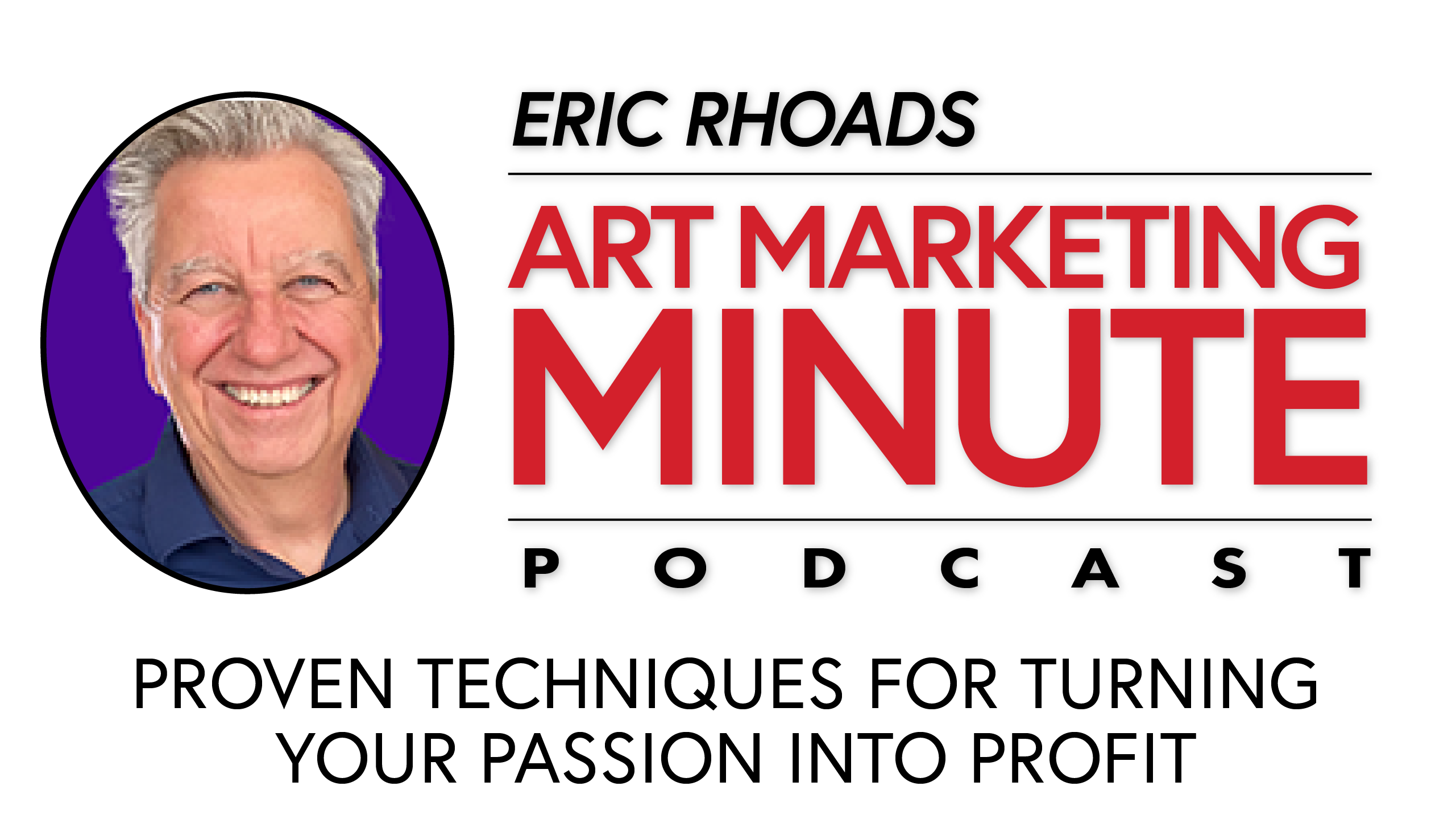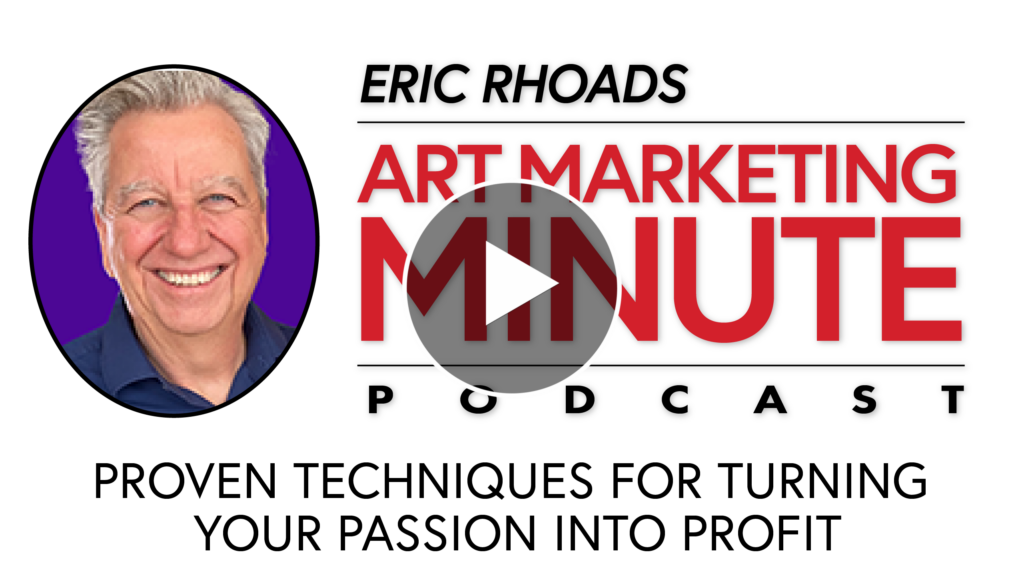Should you separate your marketing/website for multiple artistic endeavors? How can you get your website in front of more people? Eric Rhoads answers in this episode of the Art Marketing Minute Podcast.
In the Art Marketing Minute Podcast, you’ll learn how to sell your art, how to market your paintings, and everything else you need to know in order to have a successful art career. Each episode answers questions from artists by host Eric Rhoads, author of “Make More Money Selling Your Art,” publisher of several art magazines and newsletters, and author of ArtMarketing.com.
Listen to the Art Marketing Minute Podcast: Episode 95 >
Submit Your Art Marketing Question:
What questions do you have about selling your art? Email Eric today at [email protected] (include your name and where you’re from) to hear your question answered on an upcoming Art Marketing Minute Podcast.
FULL TRANSCRIPT of the Art Marketing Minute:
DISCLAIMER: The following is the output of a transcription from an audio recording of the Art Marketing Minute. Although the transcription is mostly correct, in some cases it is slightly inaccurate due to the recording and/or software transcription.
Announcer:
This is the Art Marketing Minute with Eric Rhoads, author of the Amazon best-selling book, “Make More Money Selling Your Art.” In the marketing minute we answer your questions to help your art career brought to you by artmarketing.com, the place to go to learn more about marketing. Now, here’s your host, arts magazine publisher, Eric Rhoads.
Eric Rhoads:
In the marketing minute I try to answer your marketing questions which of course you can email to me, [email protected]. This is a question from Kara. Head del Lago HD a l Gao hit a Lago. I’m sorry, Kara, I’m sorry, botched her name. She asked for those of us who work in multiple mediums should we separate our marketing? For instance, should a sculptor and a painter have two different websites? One for each? Well, Kara? I think it’s an interesting, interesting question. And I think it depends entirely on where you are in your career. If you’re known and established in one area, or both areas, I think you can get away with it. Artists are creative, they try to use different mediums Sargent did watercolor and oil. George Carlson was a great sculptor, and then decided to move to painting. Richard McKinley, a brilliant pastels is also a brilliant oil painter, Cynthia Rosen a palette knife oil painter, also just recently started doing watercolor for travel, there really are no rules and you of course can do anything you want. The issue comes down to are you confusing the audience? I’m a big fan in marketing, a single focus when you’re branding and marketing, you know, so if you were to walk, walk up to somebody or awaken in their sleep and say, you know, what kind of a painter is Cynthia Rosen? The instant answer is, well, she’s an oil palette, knife painter. And so you want them to know what you are, you could argue there’s room for saying there’s that you’re lots of things. And that’s okay. But if you don’t want to confuse people, you might want to wait till you’re really selling well and very established, and then maybe kind of start talking about the other things you do doesn’t mean you can’t do them. And I would not do separate websites, show who you are, whatever it is. And you know, what matters most is that you’re showing great artwork and showing that you’re, you’re competent, and hopefully a great artist, and get known for something. And you know, consumers easily get confused. They’re not paying very close attention anyway. So there’s not a right or wrong, but I do think you could do in your sales a touch if you confuse consumers. So I hope that helps.
Next question comes from Cindy Lund, who says, I have a website, how do I get in front of other people? Well, I think that’s a good question, Cindy. I heard from a person recently who said, Now that I have a website, I’m surprised that you know, the phone has been ringing off the wall with people buying my art. Well, it’s just not the case, just having a website is kind of like having your name in the phonebook. It’s not going to do anything unless people are coming to it. They’re coming to it because they’re looking for you just like the phone book, or unless they stumble on to you by accident. Now that can happen are lots of ways to drive traffic. The first is organic search, meaning you show up in a search for another item, let’s say somebody does searches the term watercolor painting, and you show up on the you know, at the top of the water coloring, watercolor painting search, which is probably unlikely unless you’re really really, really getting a lot of hits, used to be easy to manipulate what they call SEO, which is search engine optimization. And it’s less easy today. Google now knows all the tricks and prevents them. But I’d suggest maybe you blog weekly on your site, make sure that lots of keywords are in it keywords being things that people would be searching for, like the term oil painting, or painting of children or whatever it is you do. And then if enough people read your blog, you’re going to show up more in search because if people are clicking on your website, Google’s going to note that so I would write your blog email link to your list your newsletter list or whatever, and hope that they click on it. And you should be building a list anyway, we’ve talked about that in the past and you should be putting your blog on social media so people can click there and clicks from different computers will signal Google to help it show your stuff more they tend to reward success. driving people to your website isn’t enough though what you do once you get them there is a bigger question. And if you want to you want them to buy or to look or to take some particular action, then you need to optimize for that and that’s another subject for another time I talked about it in my book a little bit. Also, advertising is the most common way to drive people to a website. Remember that you want qualified art buying customers you know if you’ve got a lot of people who love art, but they don’t buy art that’s not going to do you any good. Since plein air magazine, the readers buy lots of art even the artists buy lots of art but you got the people who follow the circuit go to go to the plein air events the collectors, you know they’re buying art and they love plein air paintings and so that’s a good place to advertise and get them to come to your website. Or you know, my magazine, fine art kind of sir. Same kind of thing. You’ve got all these qualified art collectors. Even things like fine art today plein air today, realism today, American watercolor, the things that are going to reach the people who are going to buy are going to make a big difference, but you want audiences that are proven buyers. Because if you just grab audiences in general that’s just not help enough. You want things that are you want to reach people were going to buy.
Well, this has been the art marketing minute with me. Eric Rhoads. My goal in life is to eliminate the idea of the starving artist to help your dreams actually come true. So if you want to submit questions, simply email [email protected]. And to learn more about marketing ideas, you can visit Artmarketing.com. Thanks for listening.
How to Submit Your Art Marketing Questions: What questions do you have about selling your art? Email Eric today at [email protected] (include your name and where you’re from) to hear your question answered on an upcoming Art Marketing Minute Podcast.



Leave A Comment